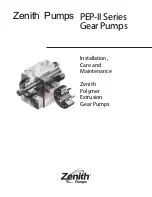
7
(1) Follow the
Pressure Relief Procedure
, above and disconnect the fluid line. If the pump star
when the air is turned on again, the line, etc. is clogged.
Pump does not operate
Air motor not tripping over
Air leaking from exhaust
Fluid leaking from exhaust
Erratic pump operation
Pump runs “wild”
Fluid output on one stroke only or
continues to operate when dispensing
valve is closed
Pump operates, but output low on both
strokes
I
nadequate air supply pressure or
restricted air line
Clogged fluid lines, hoses, valves, etc.
Damaged air motor
Empty fluid supply
Air motor o-rings are worn/damaged
Worn or damaged air motor o-ring
and/or seal, etc.
Seal (30) is worn and/or damaged
Air entering suction line
Fluid level too low
Air motor icing
Empty fluid supply
Blockage in pump tube or footvalve
Lower ball is stuck in footvalve
Lower seal (6) on fluid piston is worn
or damaged
Retainer (38) is broken (ball floats with
fluid)
Upper ball (14) is lodged in piston (15)
Inadequate air supply pressure or
restricted air lines
Closed or clogged solenoid valve, meter,
dispensing valve, etc.
Empty fluid supply
Air inlet strainer/filter clogged
I
ncrease air supply; clear
(1)
Open; clear
(1)
Service/replace air motor
Refill, reprime and/or flush
Service/replace air motor
Service/replace air motor
Replace
Check for loose connections
Refill, reprime or flush
Run pump at lower pressure; run
at lower cycles per minute; clean
mufflers
Refill, reprime or flush
Remove pump tube; clean blockage
Replace ball and reseat footvalve
Replace with new seal
Service and replace
Service and replace
Increase air supply; increase delivery
line size
Clear
(1)
Refill, reprime or flush
Clear
(1)
TROUBLE
PROBABLE CAUSES
REMEDY
Pressure Relief Procedure:
To reduce the risk of serious bodily injury, including fluid injection or
splashing into the eyes and/or onto the skin, follow this procedure
below before maintaining and/or repairing the pump, solenoid
and/or impulse meter or any part of your system.
1. Disconnect the air supply from the pump.
2. Open the dispensing valve into an approved waste container
to relieve pressure on the system.
3. Leave any bleed-type drain valves open until you are ready
to use the system again.
TROUBLESHOOTING GUIDE
NOTE:
Check all other possible causes before
disassembling the pump.
CAUTION:
Before servicing
reduce fluid supply pressure to zero.
!






























